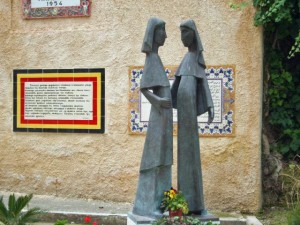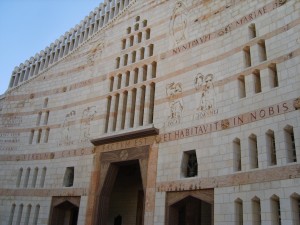This text from Isaiah has been a source of controversy among the Christian churches. It all hinges on the original word which meant young woman. It came to be translated virgin. Originally, Isaiah 7 (10-14; 8-10) was not a prediction of the future. It was a statement that a young woman (almah) would bring forth a son who would be “God with us.” This was to happen within the Davidic dynasty.
There are three Isaiahs. Second Isaiah moves beyond divine monarchy or dynasty to the concept of God among us as the Suffering Servant. The 4 Servant songs will be attributed to the suffering Jesus during Holy Week. This is a whole new concept of God among us as one who suffers and dies to show us the face of the nonviolent, nontribal God.
Jesus, in the words of the Psalmist, came to do the will of God. Like Jesus, we search for the will of Abba God. Jesus came to show us how to enter into union with God. He came to invite us to abandon ourselves to a compassionate, merciful, loving God. Contemplation, coming to know God and the will of God, involves suffering and, most of all, selfless service to others. Mary models this in today’s Gospel reading.
We need to think about what the author is saying in Hebrews (10:4-10). God does not desire sacrifice. Sacrifices were designed to appease angry, tribal gods. Our “sacrifice” is to abandon our false selves and to enter into union with the Living God. As the author says, to do the will of God and not our own will. After Jesus, sacrifice is not necessary to appease a punishing God because we live in Christ who lives in union with God. “Christ lives in me.’ If we could but realize the beauty and power of this. We live in the person, power, and presence of the Risen Jesus. As Micah says, we walk humbly doing justice and seeking mercy.
Today we celebrate Mary’s fiat, “Let it be done to me according to your will.” (Luke 1:26-38) This is from Luke’s nativity story. Only Luke and Matthew have accounts of the nativity and their accounts vary. Both accounts represent the efforts of early church communities to deepen their understanding of the Risen Jesus.
Matthews with his “genealogy” and Luke with this account are telling us that Jesus is the “messiah.” After the collapse of the Davidic dynasty, the messiah was to be the king who would restore Israel to the glory days of David and Solomon. Jesus, therefore, is a descendant of David.
The essence of this account is Mary’s fear. She faces the unknown and unexpected. She will conceive a son out of wedlock. We can only imagine the angst in her heart. Her false self wants to run away and hide. She would rather not be where she is; however, she models for us the essential ingredient of union with God-abandonment of our false selves, our wills in favor of doing what God expects of us. Mary’s finds in her depths her true self that is ready to let God fill the emptiness of her angst with God’s abounding love.
Accepting God’s will, Mary then models abandonment of will in service. She immediately goes to her cousin who needs her help. You can appreciate Mary’s obedience to God’s will even better if you have been to Israel. It is a long way through rugged terrain from Nazareth in Galilee to Ein Karem near Jerusalem.


